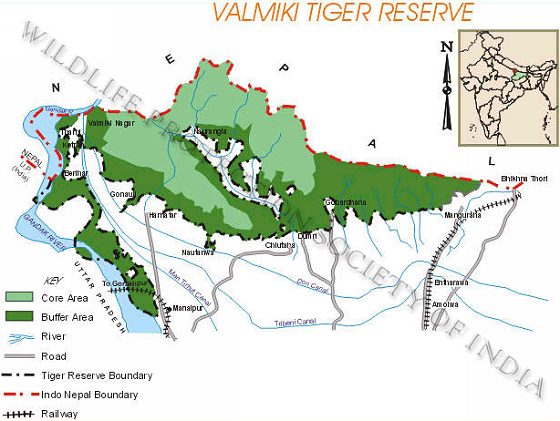Tiger Reserves
| |
|
|

|
|
Valmiki
Tiger Reserve
|
|
State
|
Bihar
|
History
|
|
Altitude
(above M.S.L.)
|
125
– 880 m
|
A
part of the area was notified as a sanctuary
in 1978. The Tiger Reserve was created in
1989-90. At the same time, in 1989, its
core area was declared a National Park.
|
|
Area
|
Total
|
840.2
km²
|
|
Core
|
335.6
km²
|
|
Buffer
|
504.6
km²
|
|
Flora
and Fauna
|
|
Valmiki
is located in an area with a highly fragile
geological formation. The Gandak and Masan
Rivers that drain the catchment area. They
change their paths frequently due to the
erosion-prone sandy soil. The forests of
this reserve support an estimated 53 tigers.
|
|
Temperature
|
8°C
- 36°C
|
|
Rainfall
(per annum)
|
1461
- 2053 mm
|
|
Seasons
|
Winter
|
Nov
- Feb
|
|
Summer
|
Mar
- Jun
|
|
Monsoon
|
July
- Sep
|
|
Forest
Types
|
|
West
Gangetic Moist Mixed Deciduous Forest, Bhabar
Dun Sal Forest, Dry Siwalik Sal Forest,
Khair-Sissoo Forest, Cane Brakes, Eastern
Wet Alluvial Grassland, Barringtonia Swamp
Forest
|
|
Fauna
|
|
Tiger,
leopard, fishing cat, leopard cat, sambar,
hog deer, spotted deer, black buck, gaur,
sloth bear, langur, rhesus monkey, etc.
|
|
Funds
|
Insufficient
& delayed
|
Management
Objectives
|
|
Staff
|
Understaffed
|
Since
the creation of the Tiger Reserve, not much
has been done by way of development. Some
infrastructure improvements have been made.
|
|
Problems
|
|
Timber
felling and the smuggling of trees, such
as teak and cane, is a huge problem. Armed
gangs settled in nearby Nepal are involved
in these activities. Animal poaching also
takes place. Livestock grazing is another
problem, exposing wild herbivores to iodine
deficiency disease, Goitre and Foot and
Mouth disease.
|
|
External
Influences (1991 census)
|
|
Villages
|
142
|
|
Human
population
|
81,000
|
|
Livestock
numbers
|
60,000
|
|
|

|
|